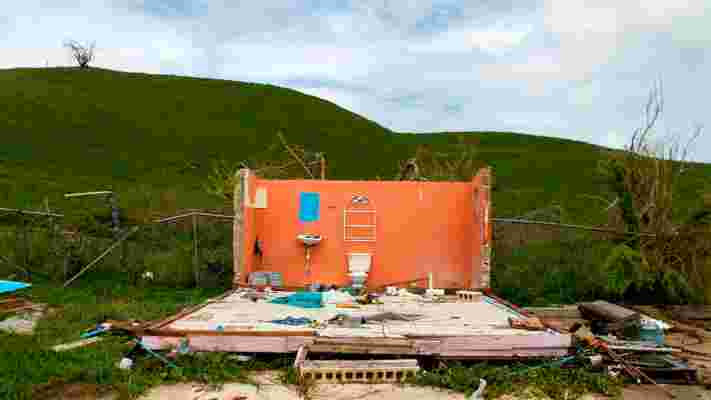April 25,2022
A Puerto Rican Architect Explains How Rebuilding the Country Will Take More Than Brick and Mortar
by David Stewart
When Hurricane Maria made landfall in Puerto Rico, it devastated the island, leaving it, nearly three weeks later, without electrical power and struggling for essentials—food, water, and basic medicine. In the midst of what will be an undoubtedly long and intense recovery, and as Donald Trump prepares, today, to make a visit, AD spoke with Puerto Rican architect and founder of WAI Think Tank—a firm recently short-listed for the design of the National Center for Contemporary Arts (NCCA) in Moscow—Cruz Garcia, about the conditions that made for such a devastating outcome, and the best way forward as Puerto Rico begins to consider its future. As he puts it, “there will be a pre-Maria Puerto Rico and a post-Maria Puerto Rico.” We asked him about both.

Natural disasters—so called—are really only disasters when they intersect with underlying human-made vulnerabilities. Absent those vulnerabilities, which put human lives at risk, these extreme events are just that: weather. When Hurricane Maria swept through the Caribbean, it revealed a host of vulnerabilities that had lain just beneath the surface, making that weather system nothing short of a disaster. In Puerto Rico, where the island is still without electricity, the territory is still facing extreme challenges to other infrastructure systems, like water, transportation, and medical services, and is still likely to see its death toll mount, the storm was particularly devastating. “This is the worst catastrophe we’ve ever had,” says Garcia. “It’s the saddest thing I’ve seen in the country, ever. Nothing even compares to this.”
Though the island’s energy infrastructure crisis is the most immediately perceivable outcome, and though Puerto Rico will need to address this vulnerability in the rebuilding process, many Puerto Ricans look elsewhere—to governance—when considering the island’s most glaring vulnerabilities. As Garcia explains, “What was there before was not working, and that is related to politics and the economy—to the fact of being a colony in the Caribbean.”
Donald Trump’s recent dustup with the mayor of San Juan, Carmen Yulín Cruz, provides a case in point, highlighting the tenuous relationship between Washington, D.C., and San Juan, made evident with Trump’s suggestion that Puerto Ricans should rebuild on their own (“They want everything to be done for them,” he complained in a tweet), citing the San Juan mayor’s “poor leadership” as the culprit.
“People drowned on their own beds and people are desperate to get medicine, and this guy’s on Twitter making an infantile attack,” Garcia says. “It’s shameful, but I wasn’t expecting to hear anything smarter from him. There is no sign of human dignity.”
More than a Twitter flare-up, though, the relationship between Puerto Rico and the U.S. contains deep, structural challenges. “It has been a sort of semiautonomous government,” Garcia explains. “We pass laws, but there is no sovereignty, so we can’t trade, which makes it impossible to grow the economy in a sustainable way because of all the limitations. There is a very longstanding relationship that the U.S. has toward its colonies, and here, you can see the evidence of interest lying in different places.”
“Real-estate development [and] even tourism are hampered by this colonial condition, too,” Garcia adds, pointing out the efforts made to develop areas with wealthy tourists, while marginalizing low- and moderate-income locals to the risk-prone margins. Extreme climate events tend to reveal socioeconomic disparities, and in Puerto Rico, Hurricane Maria did just that, laying bare, in tragic ways, the vulnerabilities of disadvantaged populations. “There were so many poor people living in flood-prone areas,” Garcia explains. “In areas developed on former river beds, which are the first to flood, people put poor people there,” he adds. “Puerto Rico has had a very laissez-faire attitude to development. Whoever has the money makes the decisions, so they put the most vulnerable people in the most vulnerable places.”
For Garcia, as it is for many others, rebuilding will need to address Puerto Rico’s condition holistically. There will be hammer-to-nail efforts to put back structures, yes, but in his opinion, the underlying systems need to be rebuilt, too, beginning with the legacy of colonial governance, and including the economy, infrastructure, and land use. “It’s too early to think about architecture at this point,” he concedes. “We need to think about the fundamentals.”
When asked about what it will take to rebuild the island, Garcia responded in this way: “I don’t even want to say ‘rebuild,’ because we shouldn’t even be thinking about putting things back the way they were. This is an opportunity to rethink our role as architects. More than ‘rebuilding,’ we need to be talking about the construction of a better society.”






